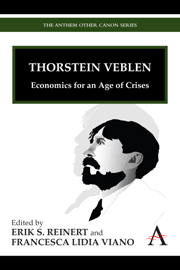Book contents
- Frontmatter
- Contents
- Acknowledgements
- List of Contributors
- 1 Introduction
- 2 Veblen's Contexts: Valdres, Norway and Europe; Filiations of Economics; and Economics for an Age of Crises
- Part One Norwegian Origins and Personal Life
- Part Two American Education
- Part Three Veblen's Politics
- Part Four Veblen's Economics
- 12 Thorstein Veblen: The Father of Evolutionary and Institutional Economics
- 13 Veblen's Words Weighed
- 14 The Great Crash of 2007 Viewed through the Perspective of Veblen's Theory of Business Enterprise, Keynes's Monetary Theory of Production and Minsky's Financial Instability Hypothesis
- 15 Predation from Veblen until Now: Remarks to the Veblen Sesquicentennial Conference
- 16 Capitalising Expectations: Veblen on Consumption, Crises and the Utility of Waste
- 17 Thorstein Veblen: Still Misunderstood, but More Important Now than Ever
- Name Index
- Subject Index
15 - Predation from Veblen until Now: Remarks to the Veblen Sesquicentennial Conference
from Part Four - Veblen's Economics
Published online by Cambridge University Press: 05 May 2013
- Frontmatter
- Contents
- Acknowledgements
- List of Contributors
- 1 Introduction
- 2 Veblen's Contexts: Valdres, Norway and Europe; Filiations of Economics; and Economics for an Age of Crises
- Part One Norwegian Origins and Personal Life
- Part Two American Education
- Part Three Veblen's Politics
- Part Four Veblen's Economics
- 12 Thorstein Veblen: The Father of Evolutionary and Institutional Economics
- 13 Veblen's Words Weighed
- 14 The Great Crash of 2007 Viewed through the Perspective of Veblen's Theory of Business Enterprise, Keynes's Monetary Theory of Production and Minsky's Financial Instability Hypothesis
- 15 Predation from Veblen until Now: Remarks to the Veblen Sesquicentennial Conference
- 16 Capitalising Expectations: Veblen on Consumption, Crises and the Utility of Waste
- 17 Thorstein Veblen: Still Misunderstood, but More Important Now than Ever
- Name Index
- Subject Index
Summary
The language of the market serves a social function, which is to obscure and also to sanitise many economic encounters – especially encounters between the large business enterprise on one side and its customers, workers and suppliers on the other. On the blackboard, these encounters appear balanced: the supply curve matches that of demand; both are drawn in lines of equal width. The underlying thought is that by their weight of numbers, consumers, workers and suppliers just offset the mass of the organised firms. But of course no such balance exists in real life. There is every difference between an organised and a disorganised force, between an army and a mob. Thus, the lived experience of the relationship between the private individual and the business firm is, always and everywhere, one of a radical difference in power. The appropriate way to think about this is in terms that acknowledge the imbalance, and, although the fact is not very well known, for this purpose there already exists an economics of predator and prey.
- Type
- Chapter
- Information
- Thorstein VeblenEconomics for an Age of Crises, pp. 317 - 328Publisher: Anthem PressPrint publication year: 2012

